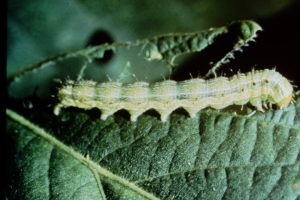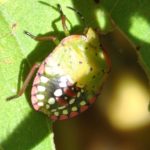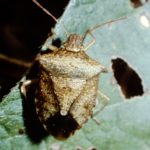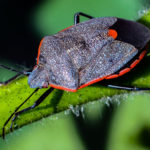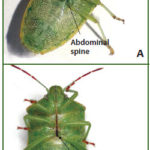Soybean Insects: Late-Season Pests (R1 to R7)
Soybean Podworm, Helicoverpa zea
The soybean podworm (Fig. 30) is the same insect as the cotton bollworm and corn earworm. The larva chews through the pod to feed on the developing seeds and also feeds on leaves and flowers. Large larvae are green, yellowish, or black with cream-colored bands running along the sides. Larvae have four pairs of prolegs and one pair at the end of the abdomen.
Use a ground cloth to collect podworm samples. Insecticide treat- ment may be justified when podworms average one medium-size larva per row foot at R1 to R5, and three medium-size larvae per row foot at R6 to R7.
Stink Bugs
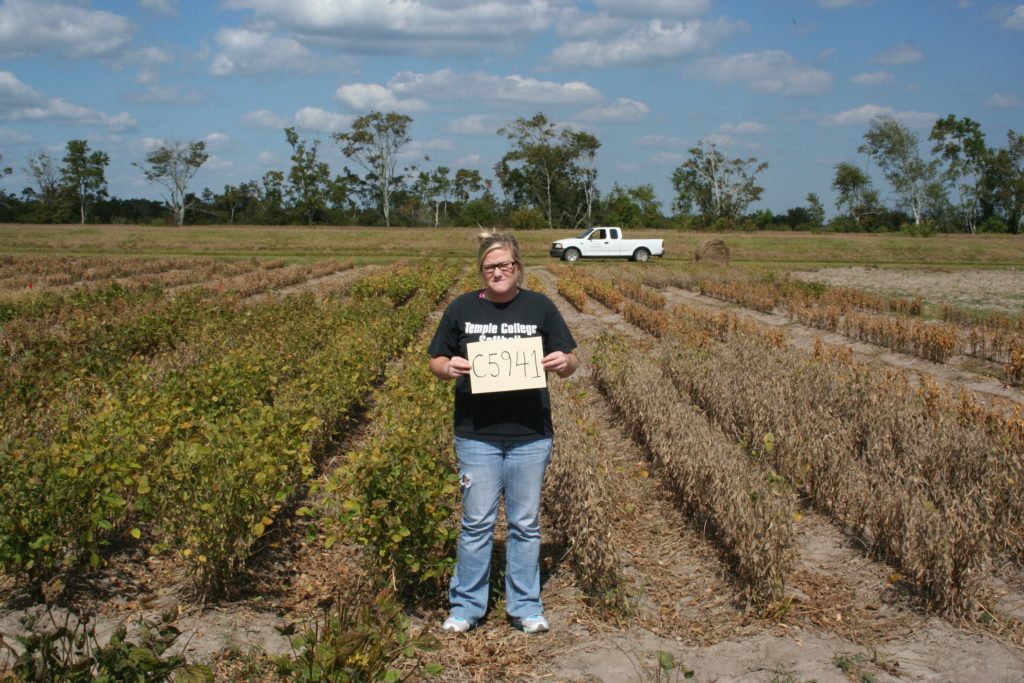 In the eastern half of Texas, stink bugs are major pests. They decrease soybean yield and quality by using their mouthparts to suck up the juices of developing flowers, pods, and seeds. Also, feeding on pods can reduce the germination of soybeans produced for seed, cause flat pod, and delay crop maturity. These disorders are extremely severe since seeds in affected pods do not expand and fill, damaged plants retain leaves and do not mature, and stems remain green, delaying or preventing harvest (Fig. 31). Entire fields can suffer total loss of yield.
In the eastern half of Texas, stink bugs are major pests. They decrease soybean yield and quality by using their mouthparts to suck up the juices of developing flowers, pods, and seeds. Also, feeding on pods can reduce the germination of soybeans produced for seed, cause flat pod, and delay crop maturity. These disorders are extremely severe since seeds in affected pods do not expand and fill, damaged plants retain leaves and do not mature, and stems remain green, delaying or preventing harvest (Fig. 31). Entire fields can suffer total loss of yield.
Stink bugs can damage soybeans from first pod formation (growth stage R3) through full seed development (growth stage R6). Regular and frequent scouting is crucial because this period can last up to 7 weeks. No Texas data are available for stink bug damage to R7-stage soybeans.
Each year, multiple generations of stink bugs can develop first on legume weeds, then on soybeans when they begin to flower.
Several stink bug species attack soybeans. Research has not identified or quantified the differences in feeding behavior and damage potential among these species. When sampling for stink bugs, combine all species to arrive at a total number of stink bugs per sample.
Immature stink bugs (nymphs) look like the adults but do not have wings. If you find nymphs in the field, stink bugs are reproducing, meaning the infestation began earlier.
Stink bug eggs are barrel-shaped and laid in masses on the plant. When the eggs hatch, nymphs emerge and pass through five stages before becoming adults, growing larger with each stage. Although adults cause the most damage, large nymphs can also be destructive.
Most stink bugs feed on plants, but the spined soldier bug (also a stink bug) feeds on caterpillars, including many pest species.
Southern Green Stink Bug, Nezara viridula
Frequently the most common stink bug species in Texas soybean fields, southern green stink bug adults are relatively large (about ½ inch long and 5/16 inch wide across the thorax), green, and look much like green stink bugs (Fig. 32). To distinguish between the two species, look at the small forward-projecting spine on the underside of the insect between where the hind legs attach to the body. The end of this spine is short and rounded in the southern green stink bug, but longer and pointed in the green stink bug. Also, the southern green stink bug has reddish bands on the antennae and the green stink bug has black ones. Older southern green stink bug nymphs (Fig. 33) are green with white, black, and red spots on the top of the abdomen.
Green Stink Bug, Chinavia hilaris
The green stink bug is also common in soybean fields in eastern Texas. The adult green stink bug (Fig. 34) is a little larger (about 5/8 inch long and 3/8 inch wide across the thorax) than the southern green stink bug. Older nymphs are green with black markings on the thorax and abdomen (Fig. 35).
Brown Stink Bug, Euschistus spp.
Brown stink bugs represent a group of related species. Adults of these stink bugs are about 3/8 to 7/16 inch long and 3/8 inch wide across the thorax. Adults and nymphs are predominantly brown (Fig. 36).
Compared to other stink bugs, brown stink bugs are more difficult to control with some pyrethroid insecticides.
Redbanded Stink Bug, Piezodorus guildinii
Populations of the redbanded stink bug have increased along the Texas Gulf Coast. It is also present in northwest Louisiana, while distribution in northeast Texas is not well documented.
The adults are light green with a reddish band across the top of the junction between the thorax and abdomen (Fig. 37). They are about 3/8 to 7/16 inch long and ¼ inch wide across the thorax, so they are smaller than southern green stink bugs and green stink bug adults.
Older nymphs are green and somewhat flattened, with a pattern of red and black markings on the top of the abdomen (Fig. 38).
Field trials show that insecticides and rates recommended for other stink bug species are also effective against redbanded stink bugs.
They fly from plant to plant in soybean fields and redbanded stink bug damage, such as flat pod, is localized to the feeding sites. This means that these insects are mobile and voracious feeders, since damage in affected fields is frequently widespread.
Redshouldered Stink Bug, Thyanta spp.
The redshouldered stink bug is common in soybeans in northeast Texas (Fig. 39). It resembles the redbanded stink bug because of a reddish band across the top of the body between the thorax and abdo- men. However, the redbanded stink bug has a long spine protruding between its hind legs; this long spine is lacking in the redshouldered stink bug (Fig. 40).
Chlorochroa ligata
This stink bug occurs in soybean fields in the Coastal Bend region. Although damage to soybeans has not been reported, it does occur on alfalfa, corn, cotton, peppers, sorghum, tomatoes, and various fruits. Mesquite is a common weed host plant.
Adults are dark with a narrow, reddish-orange border that surrounds the thorax and abdomen (Fig. 41). The end of the scutellum (shield-shaped plate covering a portion of the abdomen) also has a reddish-orange spot.
Management and Treatment Thresholds for Stink Bugs
When making treatment decisions, sample stink bugs using a sweep net or ground cloth and combine all species for a total number of stink bugs per sample. Consider treatment when stink bugs average 36 or more adults and older nymphs per 100 sweeps, or one or more adults and older nymphs per row foot. The redbanded stink bug causes more damage per individual than other stink bug species. Consider treatment when redbanded stink bugs average 16 adults and older nymphs per 100 sweeps.
A variety of insecticides control stink bugs, but be aware that the period of vulnerability when pods are developing is up to 7 weeks, making insecticides with long residual activity a good option. Contin- ued scouting is imperative because flying adult stink bugs can re-infest soybean fields after an insecticide application. Many farmers in the southeastern US have adopted the ESPS (Early Soybean Production System), which, in certain production areas, is vulnerable to stink bug attack.
